A brief history of the Island’s Railways
The Isle of Wight Steam Railway and its place in the history of the Island’s railways.
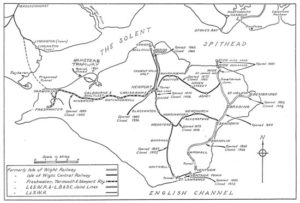 The Isle of Wight Steam Railway passes through five miles of unspoiled Island countryside between Wootton and Smallbrook Junction, recapturing the days of the branch line railway.
The Isle of Wight Steam Railway passes through five miles of unspoiled Island countryside between Wootton and Smallbrook Junction, recapturing the days of the branch line railway.
Until the 1950’s the island boasted 55 miles of railway line. Of these the ‘main line’ from Ryde Pier Head to Ventnor was the busiest, also serving the principle holiday resorts of Sandown and Shanklin. At the other extreme, the rural lines to Freshwater and Ventnor West were never profitable and epitomise the sleepy country branch line.
Timeline of the Isle of Wight Railways
1832 Hamstead Tramway
Regarded by historians as the Island’s first railway and built to a relatively high standard, the 2 mile long line was narrow gauge and worked by horses. It was constructed to carry goods by Royal architect John Nash serving his estate; connecting Hamstead Quay and brickworks with surrounding farm land and Hamstead House. Nash’s fortunes declined – and so did the tramway. It probably only lasted 10 to 15 years and had disappeared by 1860 when Ordnance Survey mapping was carried out.
1862 Cowes & Newport Railway
Opened on 16th June 1862, this was the first Standard Gauge (4’ 8½”) railway covering the 4½ miles between Cowes and Newport.
This Railway had two blue painted engines appropriately named Pioneer & Precursor which operated all the trains until 1880. This line remained in use for 104 years and closed on 21st February 1966.
1864 Isle of Wight Railway
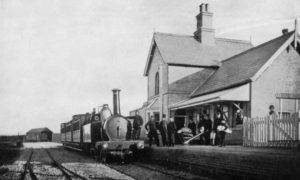 East Wight’s first railway was constructed from Ryde St John’s Road to Shanklin and opened on 23rd August 1864. The line is still in use as part of the Ryde Pier – Shanklin electric railway.
East Wight’s first railway was constructed from Ryde St John’s Road to Shanklin and opened on 23rd August 1864. The line is still in use as part of the Ryde Pier – Shanklin electric railway.
1864 Ryde Pier Tramway
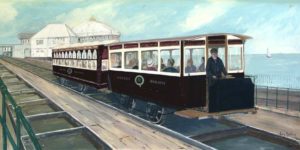 The Ryde Pier Company constructed a horse-worked tramway along the ½ mile pier. The Pier Company also experimented with steam tram engines, steam tram cars and ultimately became pioneers in the use of electric traction in 1886. In 1927 the Siemens electric power system was abandoned in favour of internal combustion rail-cars. The tramway finally closed on 26th February 1969.
The Ryde Pier Company constructed a horse-worked tramway along the ½ mile pier. The Pier Company also experimented with steam tram engines, steam tram cars and ultimately became pioneers in the use of electric traction in 1886. In 1927 the Siemens electric power system was abandoned in favour of internal combustion rail-cars. The tramway finally closed on 26th February 1969.
1866 Isle of Wight Railway
Three years after the opening of the Ryde-Shanklin section of this railway, the final stage to Ventnor, which incorporated a 1312 yard long tunnel, opened on 10th September 1866. Sadly the line failed to see its centenary by a few months and closed on 18th April 1966.
1871 Ryde Pier Tramway Extension
For some years there had been considerable inconvenience to visitors travelling between Ryde Pier and the station at Ryde St John’s Road. The tramway was extended in 1870, along the Esplanade and across a number of streets to the railway station. This extension was short lived and closed on 5th April 1880.
1875 I.W. (Newport Junction) Railway
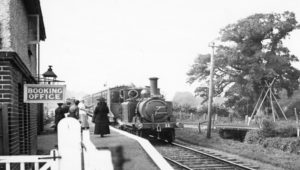 This line was planned to link Sandown, on the Isle of Wight Railway, with Newport. However there were problems with finance and construction at the Newport end; the line only getting to the outskirts of the town.
This line was planned to link Sandown, on the Isle of Wight Railway, with Newport. However there were problems with finance and construction at the Newport end; the line only getting to the outskirts of the town.
In 1879 the route from Sandown finally connected with the Cowes – Ryde railway at Newport on 1st June 1879, however it was in the hands of the Official Receiver by 1880 and the whole operation was handed over to the Joint Committee running the Cowes – Ryde line.
This railway closed on 16th February 1956.
1875 Ryde & Newport Railway
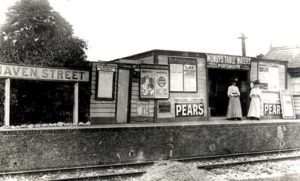 This new line ran from Smallbrook Junction, near Ryde on the I.W.Railway, through Ashey, Haven Street and Whippingham to Newport where it connected with the Cowes & Newport Railway. It opened on 20th December 1875, and the two railways were operated by a Joint Committee. This line closed on 21st February 1966, but the section from Wootton to Smallbrook Junction is now the Isle of Wight Steam Railway.
This new line ran from Smallbrook Junction, near Ryde on the I.W.Railway, through Ashey, Haven Street and Whippingham to Newport where it connected with the Cowes & Newport Railway. It opened on 20th December 1875, and the two railways were operated by a Joint Committee. This line closed on 21st February 1966, but the section from Wootton to Smallbrook Junction is now the Isle of Wight Steam Railway.
1880 Ryde Pier Head – Ryde St John’s Road
Dismayed at the treatment and inconvenience to its passengers once on the Island, the mainland railway companies who ran the ferry service built a new pier and railway to replace the tramway. This new line allowed direct access by Island trains to the Pier Head. This line is still open and forms the northern part of the Ryde – Shanklin railway.
1882 Brading Harbour Improvement Company
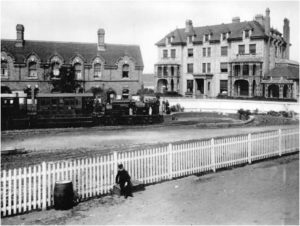 The short 2¾ mile branch from Brading to Bembridge was opened on 27th May 1882. It came about as a direct result of plans to reclaim Brading marshes, the railway utilising a dam embankment for part of its length. A quay complex was also constructed at St Helens and for about four years a train ferry operated from Langstone on the mainland. The line was absorbed by the Isle of Wight Railway in 1898 and finally closed on 21st September 1953.
The short 2¾ mile branch from Brading to Bembridge was opened on 27th May 1882. It came about as a direct result of plans to reclaim Brading marshes, the railway utilising a dam embankment for part of its length. A quay complex was also constructed at St Helens and for about four years a train ferry operated from Langstone on the mainland. The line was absorbed by the Isle of Wight Railway in 1898 and finally closed on 21st September 1953.
1887 Isle of Wight Central Railway
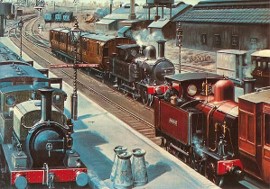 The amalgamation of the Cowes & Newport, Ryde & Newport and the I.W. (Newport Junction) Railways was a logical conclusion and took place in 1887.
The amalgamation of the Cowes & Newport, Ryde & Newport and the I.W. (Newport Junction) Railways was a logical conclusion and took place in 1887.
1889 Freshwater, Yarmouth & Newport Railway
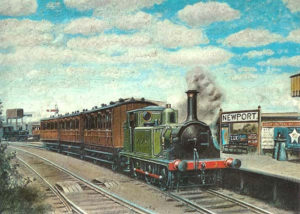 This lengthy railway opened to passengers on 11 July 1889 to serve the sparsely populated West Wight. The line was mainly a speculative venture in the hope that new ferry routes and a Solent rail tunnel would emerge in their area. The line was never busy and was worked intermittently by the I.W. Central Rly from 1914, eventually closing on 21st September 1953
This lengthy railway opened to passengers on 11 July 1889 to serve the sparsely populated West Wight. The line was mainly a speculative venture in the hope that new ferry routes and a Solent rail tunnel would emerge in their area. The line was never busy and was worked intermittently by the I.W. Central Rly from 1914, eventually closing on 21st September 1953
1897 Newport, Godshill & St Lawrence Railway
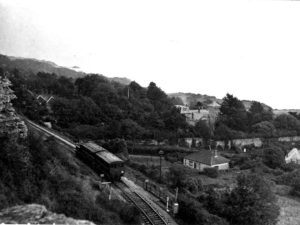 The final railway on the island to be constructed ran from Merstone to Ventnor West. It reached St Lawrence on 20th July 1897 and Ventnor in 1900 on a rock shelf through the undercliff. Without question the most scenic section of any Island railway but was sadly the most short- lived.
The final railway on the island to be constructed ran from Merstone to Ventnor West. It reached St Lawrence on 20th July 1897 and Ventnor in 1900 on a rock shelf through the undercliff. Without question the most scenic section of any Island railway but was sadly the most short- lived.
The line operated for little more than 50 years to close on 15th September 1952
1923 Southern Railway
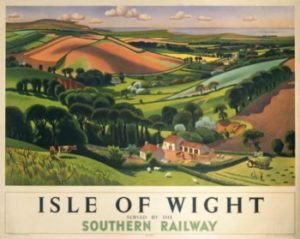 Britain’s numerous independent railways were grouped into four main companies on 1st January 1923. This was a Government measure in the early post First World War period to make the country’s transport system more efficient. All the lines on the Isle of Wight became part of the Southern Railway.
Britain’s numerous independent railways were grouped into four main companies on 1st January 1923. This was a Government measure in the early post First World War period to make the country’s transport system more efficient. All the lines on the Isle of Wight became part of the Southern Railway.
The grouping was generally regarded as a benefit on the Island as the Southern Railway invested in new infrastructure and rolling stock. Service levels increased to cope with a between-wars boom in seaside holidays.
1948 Nationalisation
 Following the Second World War in 1945, the railways generally were in a run down state. Heavy war traffic, lack of investment and manpower all taking their toll. As part of a new drive to get the country back on its feet the Government decided to bring all road and rail transport under its control, and Nationalisation became a reality on 1st January 1948. The Island’s railways became part of the Southern Region of British Railways.
Following the Second World War in 1945, the railways generally were in a run down state. Heavy war traffic, lack of investment and manpower all taking their toll. As part of a new drive to get the country back on its feet the Government decided to bring all road and rail transport under its control, and Nationalisation became a reality on 1st January 1948. The Island’s railways became part of the Southern Region of British Railways.
1952 to 1955 Branch line closures
British Railways wasted no time in closing the loss-making lines to Ventnor West (1952), Bembridge (1953), Freshwater (1953) and between Newport and Sandown (1955). The lines from Ryde to Cowes and Ventnor remained open, still using Victorian O2 locomotives and Edwardian wooden-bodies carriages. By the 1960s this bygone transport system attracted many photographers and enthusiasts to the island.
1966 Closure of lines to Ventnor and Cowes
The Beeching Report proposed the closure of all the remaining lines on the island. Despite a spirited campaign, the line from Ryde to Cowes closed in February 1966, followed in April by the line from Shanklin to Ventnor. The loss of Ventnor station was particularly keenly felt, and the town struggled to recover from this blow to its tourist industry.
1966 Steam Era Ends
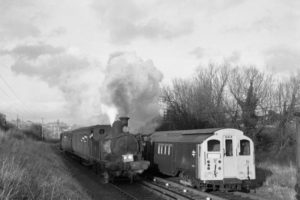 December 31st 1966 saw the end of 104 years continuous operation of the Island’s railways by steam locomotive.
December 31st 1966 saw the end of 104 years continuous operation of the Island’s railways by steam locomotive.
Only the railway from Ryde Pier Head to Shanklin was left operational. This was electrified and operated with redundant London Underground trains. All the old steam engines, carriages and wagons were broken up…..except the few precious items saved for preservation by the Wight Locomotive Society, forerunner of the Isle of Wight Steam Railway
1971 Isle of Wight Steam Railway
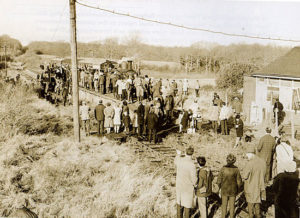 After four years of storage at the closed Newport Station, the I.W.Steam Railway was founded on 24th January 1971. Preserved stock was hauled by rail with our own locomotive driven by volunteers, from Newport to Havenstreet Station, and within a few weeks were operating a limited service on the 1½ mile section between Wootton and Havenstreet.
After four years of storage at the closed Newport Station, the I.W.Steam Railway was founded on 24th January 1971. Preserved stock was hauled by rail with our own locomotive driven by volunteers, from Newport to Havenstreet Station, and within a few weeks were operating a limited service on the 1½ mile section between Wootton and Havenstreet.
It took many years of voluntary effort to consolidate its position and provide the proper infrastructure to run and maintain both track and trains.
1986 Wootton Station reopens
 The original station at Wootton, which closed in 1953, was situated in a cutting on the opposite side of the road. Volunteers attempted to re-build this but were thwarted by the difficult clay subsoil. The cutting and bridge were filled in, and the new station opened in 1986.
The original station at Wootton, which closed in 1953, was situated in a cutting on the opposite side of the road. Volunteers attempted to re-build this but were thwarted by the difficult clay subsoil. The cutting and bridge were filled in, and the new station opened in 1986.
1991 Smallbrook Junction Extension
 With considerable help from Network SouthEast (then operators of the Ryde-Shanklin railway) and numerous other organisations and local authorities, the Steam Railway was able to rebuild over 3 miles of track from Havenstreet to Smallbrook Junction where an interchange station was built and opened on 20th July 1991.
With considerable help from Network SouthEast (then operators of the Ryde-Shanklin railway) and numerous other organisations and local authorities, the Steam Railway was able to rebuild over 3 miles of track from Havenstreet to Smallbrook Junction where an interchange station was built and opened on 20th July 1991.
The Isle of Wight Steam Railway now occupies about 5 miles of the old Ryde & Newport line, originally opened in 1875
2014: Train Story

Thanks to support from the Heritage Lottery Fund, our Train Story Discovery Centre opened in 2014, adding greatly to the facilities at Havenstreet station. As well as telling the story of the Island’s railways, the building ensures that our priceless collection of locomotives, carriages and wagons can all be stored securely under cover.
Today – The Isle of Wight Steam Railway
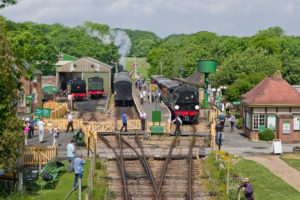 This is not quite the end of the story: The steam railway continues to develop, adding new facilities and restoring further locomotives and carriages. Our Strategic Vision explains our future aspirations.
This is not quite the end of the story: The steam railway continues to develop, adding new facilities and restoring further locomotives and carriages. Our Strategic Vision explains our future aspirations.
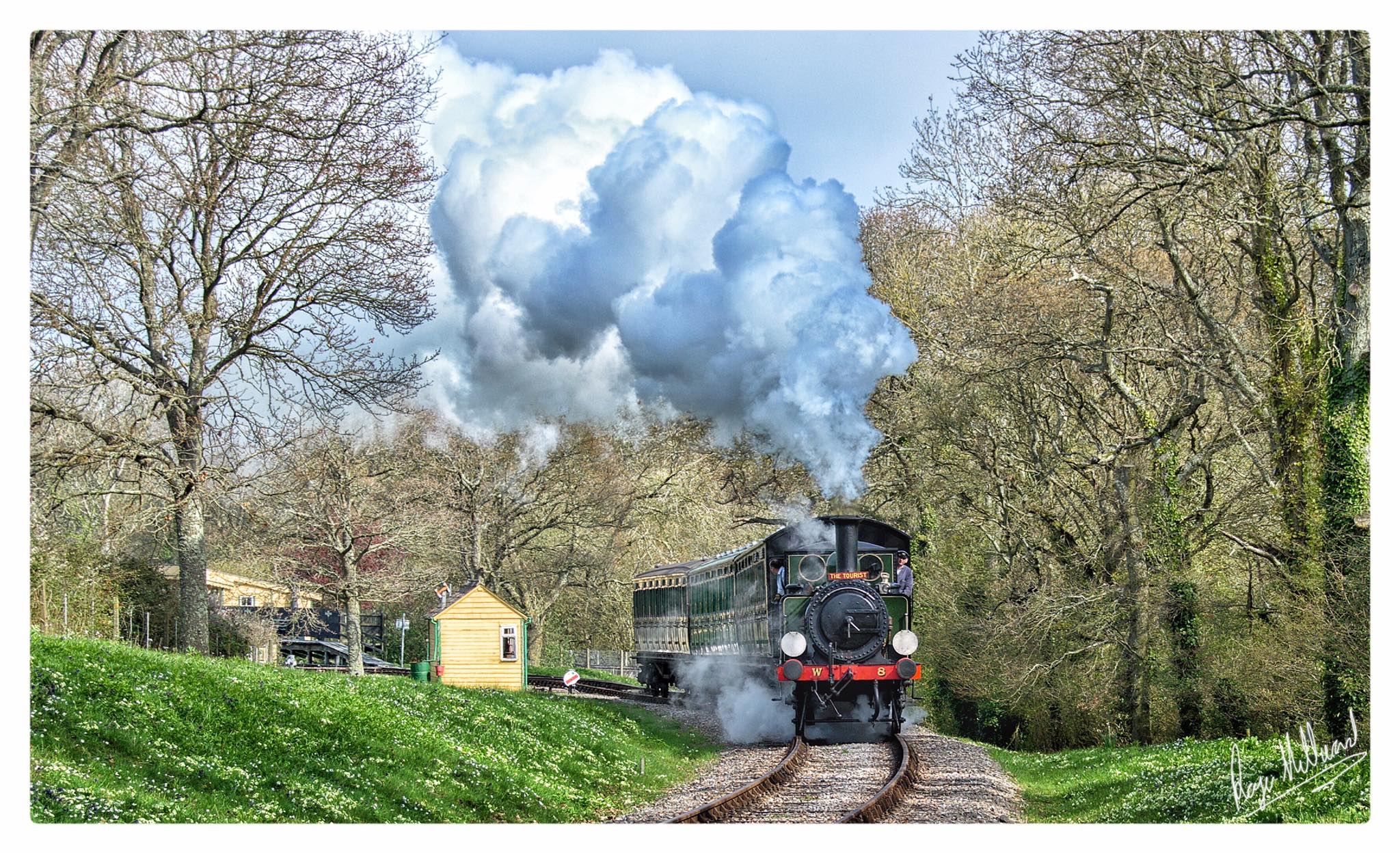
Our stations – A history
Smallbrook Junction
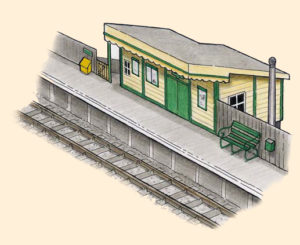 The station at Smallbrook Junction opened in 1991. Historically there was never a station on this site, just a signal box at the junction of the lines to Ventnor and Cowes.
The station at Smallbrook Junction opened in 1991. Historically there was never a station on this site, just a signal box at the junction of the lines to Ventnor and Cowes.
The Ryde & Newport Railway opened their new line on 20th December 1875, the last mile of which ran parallel to the Isle of Wight Railway’s track from Ventnor to Ryde. The two lines converged at Smallbrook Junction, although for many years there was no physical connection until they reached Ryde St John’s Road.
The Southern Railway, who took over the operation of the Island’s railways in 1923, created a new junction and signal box at Smallbrook which opened on 18th July 1926. This new connection was used during the busy summer months to speed up the flow of trains onto the single line railways to Cowes and Ventnor. In winter the two tracks reverted to single line operation controlled from Ryde St John’s Road.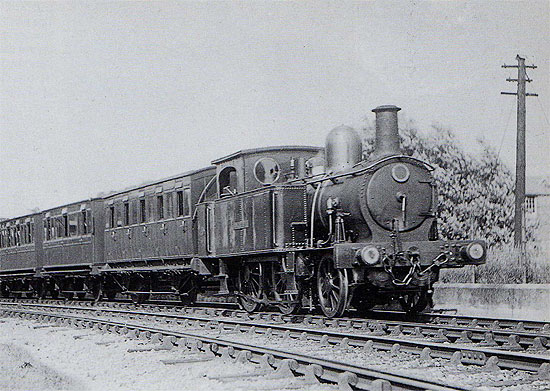
In February 1966, the railway to Newport and Cowes closed. Smallbrook Junction signal box was dismantled in January 1967 and the tracks removed in 1971.
The volunteers of the Isle of Wight Steam Railway relaid over three miles of line from its base at Havenstreet to Smallbrook and Network SouthEast, then operators of the electrified Island Line, generously funded the construction of this important interchange station. Smallbrook Junction had, for the first time, its own station which opened on 20th July 1991.
Located over the fence, between the platforms, are the concrete foundations of the 1926 signal box, carefully retained as a tangible reminder of the railway’s past.
Ashey Station
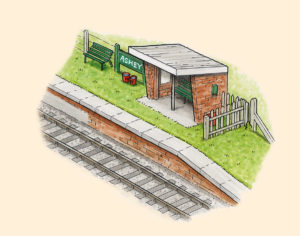 Ashey is a small rural station in the middle of nowhere. The grandness of the station was probably due to Sir Henry Oglander of Nunwell; he objected to the railway passing through his best pheasant country and the building, which is a mirror image of the ‘Royal’ station at Whippingham, may well have been a way of placating him. The station was styled ‘Ashey for Nunwell’ for some time, presumably to add a little significance to an otherwise inconsequential location.
Ashey is a small rural station in the middle of nowhere. The grandness of the station was probably due to Sir Henry Oglander of Nunwell; he objected to the railway passing through his best pheasant country and the building, which is a mirror image of the ‘Royal’ station at Whippingham, may well have been a way of placating him. The station was styled ‘Ashey for Nunwell’ for some time, presumably to add a little significance to an otherwise inconsequential location.
For years Ashey was the only crossing place between Ryde and Newport, it boasted a 12 lever frame to operate the loop and ½ mile branch to Ashey Down Quarry. In April 1882, a race course was opened immediately south of the station, bounded on one side by the quarry branch. Originally three meetings a year attracted 3,000 visitors a day.
 By 1907, the quarry was disused and the branch cut back to half its length, the remaining portion used for stabling up to three complete trains which provided a ‘mobile’ grandstand. The tracks at Ashey were rationalised by the end of 1927, after the opening of the new passing loop at Haven Street and racing ended in 1930 when the wooden grandstand was destroyed by fire in suspicious circumstances. The station returned to its sleepy existence. Eventually ground movement necessitated the building of a new three coach platform on the Down side which opened in June 1961, and it is this structure which we use to-day. The old station building was available as staff accommodation but was never popular and became near derelict. It was put on the market after the line closed in February 1966 and is now in private hands.
By 1907, the quarry was disused and the branch cut back to half its length, the remaining portion used for stabling up to three complete trains which provided a ‘mobile’ grandstand. The tracks at Ashey were rationalised by the end of 1927, after the opening of the new passing loop at Haven Street and racing ended in 1930 when the wooden grandstand was destroyed by fire in suspicious circumstances. The station returned to its sleepy existence. Eventually ground movement necessitated the building of a new three coach platform on the Down side which opened in June 1961, and it is this structure which we use to-day. The old station building was available as staff accommodation but was never popular and became near derelict. It was put on the market after the line closed in February 1966 and is now in private hands.
Soon after arrival at Haven Street, the Steam Railway secured a lease on the trackbed from Wootton to Smallbrook Junction thus preventing any unwelcome building or rights of way issues which may have prevented future extension of the track. This wise move kept the way safe for nearly 20 years before reconstruction started. As part of their support of the rebuilding programme, the Isle of Wight Council generously donated the freehold of the whole trackbed to the Steam Railway….it was time to get building!
Today, Ashey remains a quiet backwater, trains stop by request and its an ideal place for a picnic or a ramble off into the countryside; but don’t expect any mod-cons, this is rural Wight at its best!
Havenstreet Station
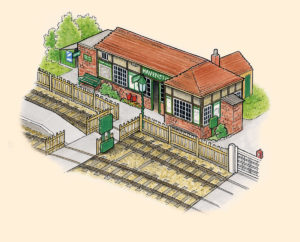 When the Ryde & Newport Railway opened in 1875, the station at Haven Street was incomplete and its location was of little consequence to the operation of the line. Even by 1876, work was still not complete and when eventually finished it comprised no more than a collection of wooden shacks on a single platform, its not surprising that the rural backwater serving Hethenstrete (road of the heathens) barely got a mention in timetables.
When the Ryde & Newport Railway opened in 1875, the station at Haven Street was incomplete and its location was of little consequence to the operation of the line. Even by 1876, work was still not complete and when eventually finished it comprised no more than a collection of wooden shacks on a single platform, its not surprising that the rural backwater serving Hethenstrete (road of the heathens) barely got a mention in timetables.
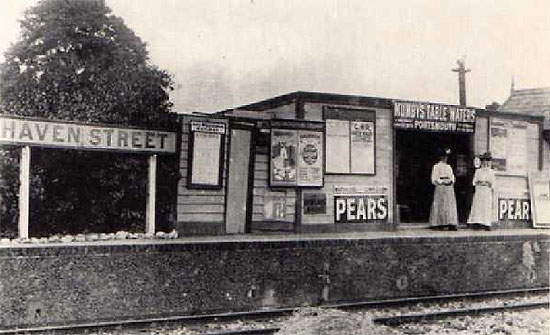
A principal landowner in the village was one John Rylands, a Manchester cotton mill owner who is probably better known for founding the John Rylands Library, an Alma Mater for religious scholars. His philanthropic works at Haven Street included the gasworks and adjacent cottages opposite the station. These were constructed in 1886, and also necessitated the building of a short siding to deliver coal to the works. The gasworks became disused in the 1920’s and the building used as a barn; the siding lingered on for another 30 years although little used.
In 1926, the station took on a new lease of life when a new island platform and station building were constructed. Haventstreet was a more convenient place to cross trains between Ryde and Newport which enabled the old loops at Ashey and Whippingham to be closed.
The ‘new’ building at Haven Street is that which you see to-day, it’s a single story structure designed to be operated by a single man. The signal-box doubles as the booking office and is located to one end, the central portion is a waiting room whose quarry tiled floor is evidence that the front of this area was once open to the weather before being enclosed in the 1930’s. At the far end of the building are the toilets, the ladies are led off the waiting area, gentlemen have to brave the elements on their way to the flat roofed extension … although it was always thus in the original plans.
Back in 1934, the station forwarded 60,986 gallons of milk to Newport and strawberries and carnations went to Covent Garden, much of this was loaded from a special timber platform built on the south side of the line close to the bridge which crosses the main road, this platform had direct cart access from the station yard. The exact date of its demise has yet to be determined but was probably around the time of the Second World War.
In the 1950’s the Post Office instigated the contracted name Havenstreet to prevent confusion although this was only partially adopted by the railway….and remains thus!
The railway closed in February 1966 although the track remained in place and the building boarded until the Steam Railway arrived on Sunday 24th January 1971.
Whilst it would have been ideal to have preserved the station’s rural idyll the requirements of a modern visitor attraction and the need to service and maintain the locomotives and carriages necessitated change. The old coal siding was reinstated at the same time as sidings connecting into the locomotive workshops; the old gasworks was purchased and now houses a small museum and store. A new shop was constructed on the site of the old tar pits and later volunteer accommodation was provided in a similarly designed building next door.
At the south-western end of the station, new sidings have been laid to accommodate an ever increasing volume of wagons and rolling stock, much of which is used by our engineers to maintain the track and lineside. Behind the Shop-Museum complex a further workshop for carriage and wagon restoration was built. This building is available to visit on most operating days and provides an up close insight into vehicle restoration.
Wootton Station
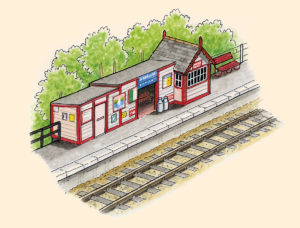 When the line opened in December 1875, Wootton station was described by Inspecting Officer Col. Yolland as a “new road side station”. It lacked amenities such as name boards, clock and conveniences….the situation was little improved by 1879!
When the line opened in December 1875, Wootton station was described by Inspecting Officer Col. Yolland as a “new road side station”. It lacked amenities such as name boards, clock and conveniences….the situation was little improved by 1879!
The platform was in a deep cutting alongside a three arch bridge carrying Beech Road,(later Station Road) over the line, about a mile from Wootton village. In 1907, a station masters’ house was constructed high above the station and an arch of the bridge was bricked in to provide ladies toilets. A booking office was also later provided in this way. To the east of the bridge an access road was provided to a new 110ft siding which was worked from a ground frame.
The station was closed on Monday 21 September 1953, although occasional trains would stop to set down or pick up local staff members until the line closed. The difficult clay conditions at the station site required constant maintenance and part of the old platform was cut back due to encroachment. The line finally closed in February 1966 and lay dormant until 24th January 1971.
The Steam Railway received less than a weeks notice to quit the Newport base and move their locomotive and rolling stock to Havenstreet through the troubled site at Wootton. A small team cleared the collapsed bank from the track and packed up the rails to allow passage of four very heavy passenger and goods trains.
Steam Railway trains started running from Havenstreet to Wootton Station Road Bridge at Easter 1971; the following year a survey of the old station site suggested it could be stabilized and reused. Work commenced but came to an abrupt halt some months later when, after a period of very heavy rain, the whole bank was in immanent danger of collapse! The scheme was abandoned and the cutting filled together with the whole area under and around Station Road bridge, which, incidentally still exists under the road by the station bus stops. The Railway made plans for a new terminus further east but it was not until 1977 that the first engine was able to run round its train. The station formally opened in August 1986.
We’re in the process of recreating an Edwardian station at Wootton with a new station building and goods shed.